This is Part 2 of a post about a very versatile resource from The Elementary Math Maniac, 0-120 Place Value Decks.
If you missed Part 1 (kindergarten), you can see it here.
If I had to choose just one word to describe The Math Maniac's resources, I think I'd have to go with thorough. Tara is most definitely a deep thinker about the mathematical possibilities of her resources and the ways that using them will look with various levels of students. Drawing on her experience as a math specialist, the background information and suggestions for implementation that she provides are logical, practical, and comprehensive.
After using the card set you see above with my five year old PreK grandson (discussed in the previous post), I also spent some time with my seven year old granddaughter, who's a first grader.
M and I started out with some basic review of Base Ten models, doing some hands-on work with Legos, since there are about a million of them in her house! Then M pulled all of the number cards between one and 30 from the card deck and then put them in order. She then did some matching of the Base Ten model cards to the numeral cards.
Next we moved on to addition. Again using the Legos to model, we spent a few moments modeling addition of a one-digit number to a two-digit number. Then we pulled the Base Ten representation cards and tried a few more of the same.
M seemed very comfortable doing all of this, so we moved right on to addition of 2 two-digit numbers. I love how the range and variety of the cards in this set allow you to make decisions like these on-the-go, responding to the needs of your students, a huge plus for your small group instruction in math.
I pulled number cards for M to add. She built models for 15 and 22, said "15 ..." and quickly discovered that grouping the ten sticks together and counting them all before counting the ones makes the process a whole lot easier. We practiced a few more addition examples that way, and then played a game.
Here's the record of what we did. To get the numbers to add, we rolled a 30-sided cube (head back to the previous post to see more fun with a a triacontahedron!) and a randomly-selected numeral card, and then took turns writing and solving the addition number models you see here. M came up with the idea of circling the sums to make it easier to compare the numbers in each row. Then she compared the numbers, marked the greater one with a check, and awarded a tally mark to the person whose sum was the greatest, marking it on the chart at the bottom of the page.
{The error in column one was discussed and fixed up after this photo was taken.}
In summary, M identified two digit numbers, sequenced them, built representational models of them, and developed a plan for adding them. Not bad for 15-20 minutes! And easily accomplished with just the card decks and one crazy die, which was a fun novelty but actually not even necessary to the success of the lesson.
Tara calls this card set the "hardest working thing (she's) ever made". I think you'll find yourself using these cards day after day, for whole class demos on your doc camera, small group teaching and exploration, and math center games. Every time the cards are used, your students ease in moving back and forth between the three representations will become more automatic.
The Math Maniac has included two things that will make this set very easy for you to use. First, there are links to some amazing blogposts loaded with ways to include these cards in your math instruction. Second, there is a very thorough list of all the relevant Common Core standards ... not just the number, but the whole standard, ready to copy and paste into your plans, for those of you that need to do that. Now, that's added value!
I hope you'll take a closer look at these three card decks here at The Math Maniac's TpT store. If you are already using them, please share your favorite use in the comments below.
Happy Teaching!






No comments:
Post a Comment
Note: Only a member of this blog may post a comment.